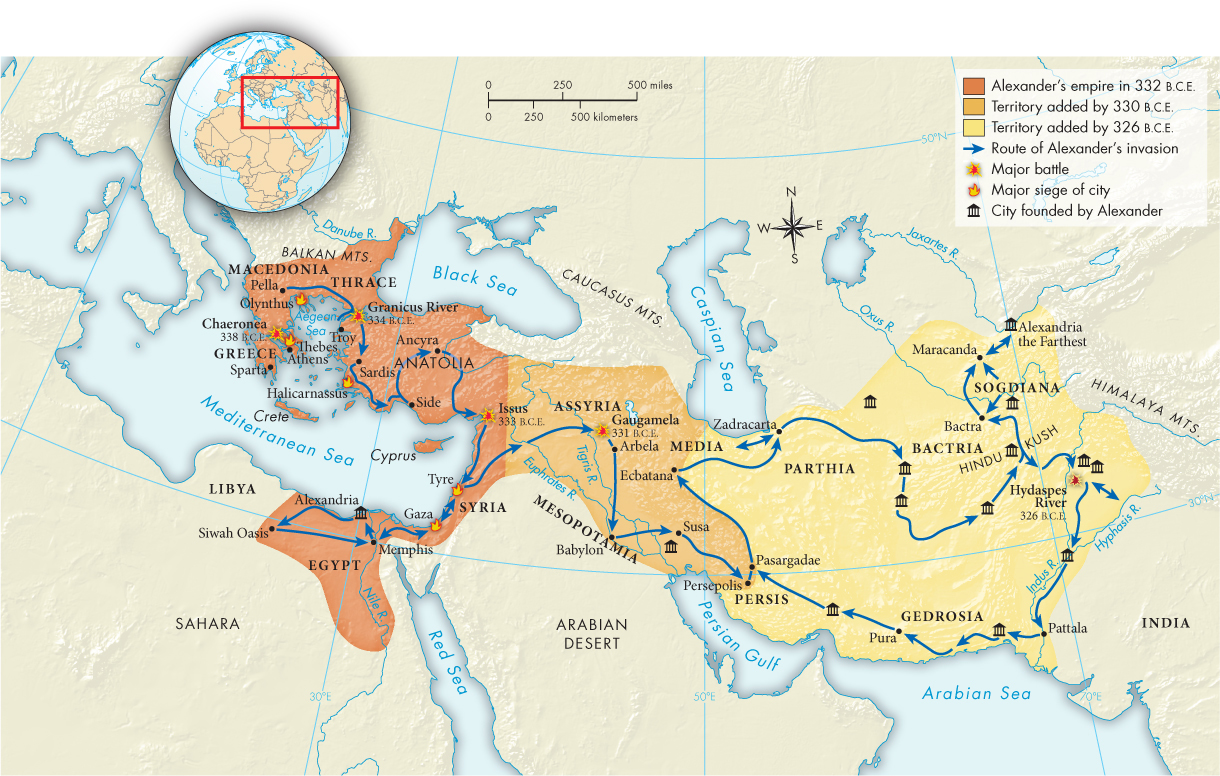From Polis to Monarchy, 404–200 B.C.E.
Immediately after the Peloponnesian War, Sparta began striving for empire over all of the Greeks but could not maintain its hold. In 371 B.C.E. an army from the polis of Thebes destroyed the Spartan army, but the Thebans were unable to bring peace to Greece. Philip II, ruler of the kingdom of Macedonia on the northern border of Greece (r. 359–336 B.C.E.), turned the situation to his advantage. By clever use of his wealth and superb army, Philip won control of the northern Aegean, and in 338 B.C.E. he defeated a combined Theban-Athenian army, conquering Greece. Because the Greek city-states could not put aside their quarrels with one another, they fell to an invader, an event that historians see as marking the end of the classical period.
After his victory, Philip united the Greek states with his Macedonian kingdom and got the states to cooperate in a crusade to liberate the Ionian Greeks from Persian rule. Before he could launch his crusade, Philip fell to an assassin’s dagger in 336 B.C.E. His young son Alexander, who had been tutored by Aristotle, vowed to carry on Philip’s mission and led an army of Macedonians and Greeks into western Asia. He won major battles against the Persians and seized Egypt from them without a fight. After honoring the priestly class, Alexander was proclaimed pharaoh, the legitimate ruler of Egypt. He ordered the building of a new city where the Nile meets the Mediterranean, a city that would soon be called Alexandria and that within a century would grow into an enormous city, rivaling Chang-an in China and Pataliputra in the Mauryan Empire of India. He also took the principal Persian capital of Persepolis and performed a symbolic act of retribution by burning the buildings of Xerxes, the invader of Greece during the Persian wars 150 years earlier.
By 330 B.C.E. the Persian Empire had fallen, but Alexander had no intention of stopping, and he set out to conquer much of the rest of Asia. He plunged eastward into lands completely unknown to the Greek world. After four years of fighting his soldiers crossed the Indus River (in the area that is now Pakistan), and finally, at the Hyphasis River, the troops refused to go farther. Alexander was enraged by the mutiny, but the army stood firm. Still eager to explore the limits of the world, Alexander turned south to the Arabian Sea and then back west (Map 5.3).

Mapping the PastMAP 5.3 Alexander’s Conquests, 336–324 B.C.E. Alexander’s campaign of conquest was extensive and speedy. More important than the great success of his military campaigns was his founding of Hellenistic cities.ANALYZING THE MAP Where are most of the cities founded by Alexander located in relation to Greece? What does this suggest about his aims?CONNECTIONS Compare this map with Map 5.2, which shows Greek colonization in the Hellenic period . What are the major differences between the two processes of expansion?
He never saw Macedonia again, however, as he died in Babylon in 323 B.C.E. from fever, wounds, and excessive drinking. He was only thirty-two, but in just thirteen years he had created an empire that stretched from his homeland of Macedonia to India, gaining the title “the Great” along the way. Alexander was instrumental in changing the face of politics in the eastern Mediterranean. His campaign swept away the Persian Empire, and in its place he established a Macedonian monarchy, although this fell apart with his death. Several of the chief Macedonian generals aspired to become sole ruler, which led to a civil war that lasted for decades and tore Alexander’s empire apart. By the end of this conflict, the most successful generals had carved out their own smaller monarchies, although these continued to be threatened by internal splits and external attacks.
Ptolemy (TAH-luh-mee) seized Egypt, and his descendants, the Ptolemies, ruled Egypt for nearly three hundred years, until the death of the last Ptolemaic ruler, Cleopatra VII, in 30 B.C.E. Antigonus and his descendants, the Antigonids (an-TIH-guh-nuhds), gained control of the Macedonian kingdom in Europe, which they held until they were overthrown by the Romans in 168 B.C.E. (see Chapter 6). Seleucus won the bulk of Alexander’s empire, his monarchy extending from western Asia to India (see “Building a Hellenized Society”), but this Seleucid (SUH-loo-suhd) kingdom gradually broke into smaller states. In terms of political stability and peace, these monarchies were no improvement on the Greek polis.
To encourage obedience, Hellenistic kings often created ruler cults that linked the king’s authority with that of the gods, or they adopted ruler cults that already existed, as Alexander did in Egypt. This created a symbol of unity within kingdoms ruling different peoples who at first had little in common; however, these kingdoms never won the deep emotional loyalty that Greeks had once felt for the polis. Kings sometimes gave the cities in their territory all the external trappings of a polis, such as a council or an assembly of citizens, but these had no power. The city was not autonomous, as the polis had been, but had to follow royal orders. Hellenistic rulers generally relied on paid professionals to staff their bureaucracies and on trained, paid, full-time soldiers rather than citizen hoplites to fight their wars.
